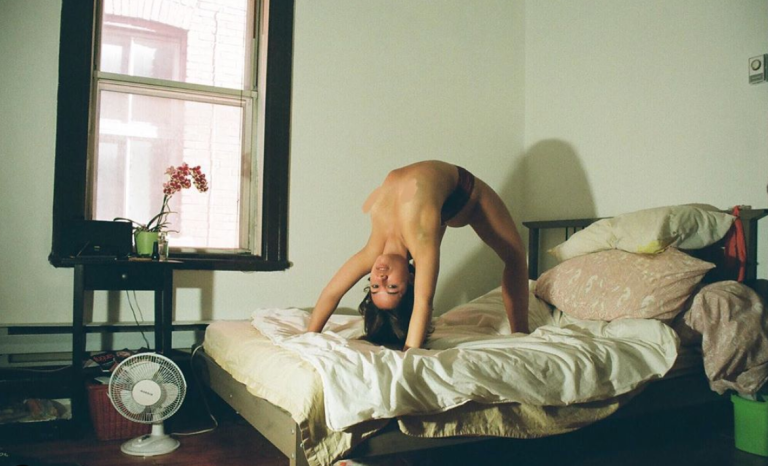Censorship and the Body – Cheyenne Skurczak
OCTOBER 22, 2019

Who decides who owns your body? In 2019, the answer is still unclear. In recent years, there have been countless movements addressing the harmful consequences of censorship of women’s bodies, ranging from #freethenipple to #metoo. Nevertheless, while there is a growing awareness of the disrespect aimed at the feminine body, online censorship continues to place the body in a constantly sexualized point of view.
Censorship in art is a widespread issue that limits different forms of representation and expression. From banning books in schools to cutting crucial scenes out of movies, censorship dampens both important information and the artist’s specific vision. On social media, however, the main target of censorship seems to be the female body.
“Your account may be deleted” was the notification that artist Laura Stromboni, founder of the Instagram page @mydearvagina, received in reaction to her posts. @mydearvagina is an account dedicated to displaying images of art, nature, and everyday objects that are reminiscent in shape or form to vulvas. The images range from blooming flowers to chewed bubble gum, and aim to normalize the vulva’s form. While there are few images displaying actual vulvas, those that do are paintings or sketches.

Stromboni’s posts have been flagged as “inappropriate” for they “contain nudity”. In reality, this was not the case. In January, Stromboni’s account was “shadow banned”, meaning that her posts do not appear on her followers’ feeds and her images do not appear when linked to hashtags. Unless followers are actively sharing the account, it is nearly impossible for the account to reach new audiences.
“I don’t think censorship is positive for any party,” says artist Jailli, known as @jailli on Instagram. Jailli’s photographs display people in their most comfortable and natural states, whatever this definition may be for them. Her photographs range from snapshots of the various faces at Montreal’s Pride Parade to people being their most comfortable in their bedrooms. Scrolling through her images reveals calm faces, soft colours, and deep intimacy.
One photograph presents a girl in a bridge pose, shooting her abdomen upward while her hands and feet are planted into her mattress. She stares directly into the camera, her face calm. She is joined by a fan on the floor, a potted-flower sitting by the window, and her wrinkled bed sheets. She wears nothing but her underwear. The image depicts a woman experimenting with her body in the most intimate place of hers: her bed. Jailli’s image reveals that a woman experimenting with her body does not always have to be sexual, no matter how she is dressed. There is an instant break in the soothing atmosphere, however, as her nipples are absent. Her breasts, which would have been the centre of the frame, are painted over with a colour similar to her own skin. Her blank chest gives off the clear image of something missing.
“I feel like I’m taking something away from a subject when I’m editing part of their body drastically by blurring their crotch area and their nipples, and by going even further and having to draw colored lines on the nipples because blurring “isn’t censored enough,” Jailli explains.
“It could be and perhaps has been very damaging for any models who work with nudity to see their bodies tampered in that way: they [trust] photographers with the process of not only seeing them naked, but also of letting the photographer photograph them.”
While Jailli’s art captures subjects at their most comfortable, Instagram forcing her to remove any appearance of nipples enforces the view that there is something unnatural about a woman in her most natural state.
Instagram’s algorithm flags any revealed nipples on a female-read breast as “sexually suggestive”. “The algorithm can’t know which images have artistic intent behind it,” Jailli says. “But even if the photo was straight up porn or photographs of someone who happens to be naked, it comes down to the female body being sexualized and the male body being seen as normal [and] accepted.”
Instagram’s algorithm, however, does not have any technology that filters through racist, homophobic, transphobic, and other damaging content. While accounts dedicated entirely to white supremacy persist, the innocence of a girl in her bedroom or an oyster shell is what is currently being deemed as “offensive”. Many artists who use the platform to promote and sell their work, it making up their living, are constantly facing the wrath of censorship. Nevertheless, racist comments, for example, are continuously passed off as opinion.
With this, Instagram’s algorithm keeps with the idea that a nipple on a male body is not sexual, while a nipple on anything Instagram reads as “female” is immediately sexualized. This discounts the reality that not all those who do have breasts identify as women and not all those who do not identify as male. By censoring only certain images, Instagram not only sexualizes the body, but supports a harmful binary.
“How the hell are [female] nipples and breasts going to perceived equally to male nipples: as simple anatomical parts? How is sexualization of the female body going to stop, both online in the real world? I think it all starts with the algorithm; our generation of the digitally fanatic is the one who will define what is “right” and “wrong” for the future, and we need to have the right people to oversee this algorithm,” Jailli concludes.
Instagram’s censorship of the breast is a reflection on the social norms that affect the female body. The immediate sexualization of women’s bodies online reflects what happens off-screen, objectifying where women are. Revolting against this form of censorship, however, requires the constant reminder that that what is most unnatural is stripping a woman of the right to represent her body.


